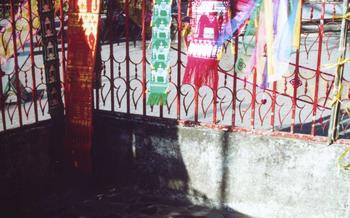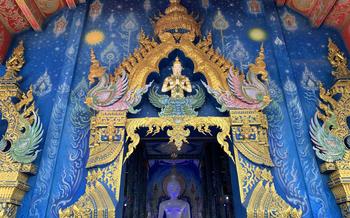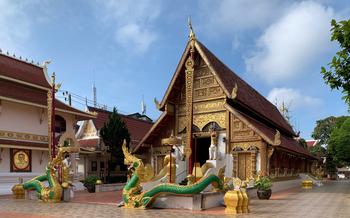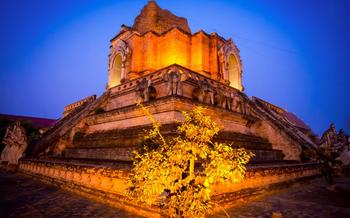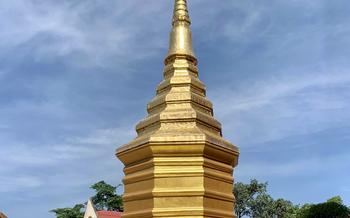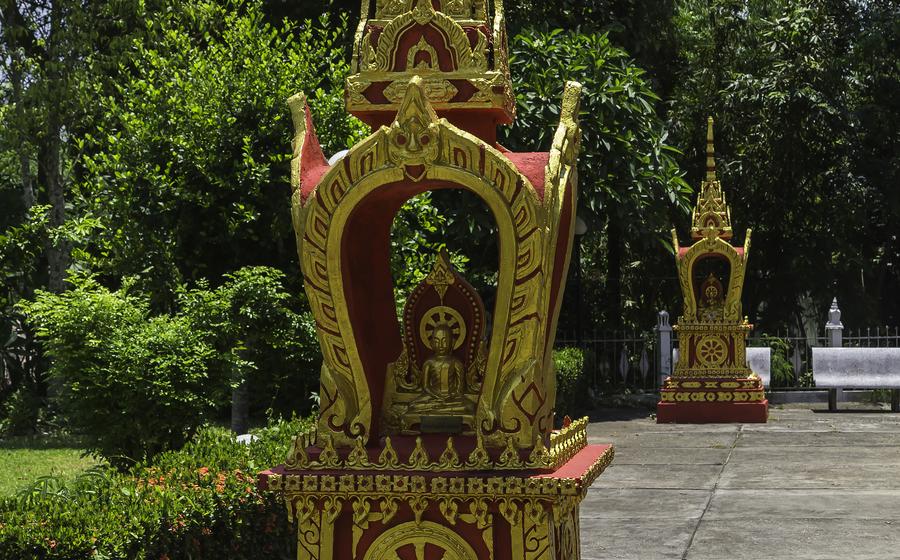
Wat Phra That Sop Waen
- Wat Phra That Sop Waen: A Sacred Mountaintop Temple
- Pilgrimage and Spiritual Significance
- Ascending the Mountain
- Temple Layout and Architecture
- Main Stupa and Relics
- Views from the Summit
- Offerings and Donations
- Local Traditions and Festivals
- Accommodation and Facilities
- Photography and Etiquette
- Respectful Photography Practices
- Ethical and Mindful Photography
- Respectful Attire and Behavior
- Guided Tours and Local Guides
- History and Legends
- Nearby Attractions and Activities
Wat Phra That Sop Waen: A Sacred Mountaintop Temple
Wat Phra That Sop Waen, perched atop a hill overlooking the picturesque town of Sop Waen in Chiang Rai, Thailand, is a sacred mountaintop temple that holds immense religious, cultural, and historical significance. Its origins can be traced back to the 14th century when it was first established as a small hermitage by a group of wandering monks. Over the centuries, it evolved into a grand temple complex, attracting pilgrims and visitors from far and wide.
The temple's architectural design is a harmonious blend of Lanna and Burmese styles, reflecting the region's diverse cultural influences. The main stupa, the temple's focal point, stands tall and majestic, adorned with intricate carvings and golden spires that shimmer in the sunlight. The surrounding viharns, or assembly halls, feature impressive murals depicting scenes from Buddhist mythology and Jataka tales.
Wat Phra That Sop Waen is not merely a place of worship but also a symbol of the deep spiritual connection between the local community and their Buddhist faith. It is believed that the temple enshrines relics of the Buddha, adding to its sacredness and attracting pilgrims from all over Thailand and beyond.
Pilgrimage and Spiritual Significance
Wat Phra That Sop Waen holds a profound spiritual significance for Buddhists and pilgrims from around the world. It is revered as a sacred pilgrimage site, attracting countless devotees who come to pay homage and seek blessings. The temple's hallowed grounds exude an aura of peace and serenity, inviting visitors to immerse themselves in spiritual contemplation and devotion.
Pilgrims undertake arduous journeys to reach Wat Phra That Sop Waen, often as part of a spiritual quest or to fulfill a religious vow. Upon arrival, they engage in various rituals and ceremonies to express their reverence and gratitude. These rituals may include circumambulating the main stupa, offering flowers and incense, and reciting mantras or prayers.
The temple is closely associated with the legend of Phra That Sop Waen, a sacred relic believed to contain a fragment of the Buddha's collarbone. This relic is enshrined within the main stupa, making the temple a particularly auspicious and holy site for Buddhists. Devotees believe that paying homage to the relic brings good fortune, protection, and spiritual merit.
The local community holds Wat Phra That Sop Waen in high esteem, considering it a symbol of their cultural and religious heritage. They participate in temple festivals and ceremonies with great enthusiasm, demonstrating their deep devotion and reverence for this sacred place.
Ascending the Mountain
Reaching Wat Phra That Sop Waen requires a captivating ascent through the verdant slopes of Doi Sop Waen. Several routes and trails offer varying degrees of challenge, catering to pilgrims and visitors of diverse fitness levels. The most popular trail, known as the "Pilgrim's Path," commences at the temple's base and winds its way up the mountainside.
The climb is physically demanding, requiring a moderate level of fitness and endurance. The path traverses steep sections, rocky terrain, and numerous steps, testing the limits of one's physical abilities. However, the arduous journey is amply rewarded by the breathtaking vistas that unfold along the way.
En route, hikers are treated to a symphony of natural beauty. The lush foliage, vibrant wildflowers, and towering trees create a captivating tapestry that delights the senses. The panoramic views from various vantage points offer glimpses of the surrounding countryside, with verdant valleys, distant mountains, and shimmering rivers forming a picturesque backdrop.
To ensure a safe and enjoyable ascent, it is advisable to wear comfortable clothing and sturdy footwear with good traction. Carrying sufficient water and snacks is essential for replenishing energy levels during the climb. Additionally, starting early in the morning or late afternoon is recommended to avoid the midday heat and humidity.
Temple Layout and Architecture
The temple complex of Wat Phra That Sop Waen is a stunning showcase of Lanna architecture, a style that blends elements of Thai, Burmese, and Mon influences. As you enter the temple grounds, you'll be greeted by a series of stupas, or chedis, each adorned with intricate carvings and glistening in the sunlight. The main stupa, known as the Phra That Sop Waen, stands tall and majestic at the center of the complex, symbolizing the pinnacle of Buddhist achievement.
The temple's viharns, or assembly halls, are equally impressive, with their sweeping roofs and elaborately decorated interiors. Inside, you'll find intricate murals depicting scenes from the life of Buddha and other religious stories. The walls are adorned with colorful ceramic tiles, and the ceilings feature intricate wooden carvings.
Each element of the temple's architecture holds symbolic meaning. The stupas, for example, represent the Buddha's journey to enlightenment, while the viharns symbolize the places where he taught his disciples. The intricate carvings and decorations serve as reminders of the impermanence of all things and the importance of detachment from worldly desires.
One of the most striking features of the temple is the naga staircase, a long and winding staircase flanked by mythical naga serpents. The nagas are believed to be protectors of the temple and guardians of the Buddha's teachings. As you climb the stairs, you'll be rewarded with breathtaking views of the surrounding countryside.
Main Stupa and Relics
The main stupa at Wat Phra That Sop Waen is a magnificent sight to behold. Towering over the temple complex, it serves as the focal point of the entire site. Its golden spire glistens in the sunlight, radiating an aura of sacredness and reverence. Within the stupa, enshrined in a chamber of great significance, lie the relics of the Buddha. These relics are believed to be fragments of bone or hair, and their presence adds an immense spiritual significance to the temple.
The history of the relics is shrouded in mystery and legend. According to local lore, the relics were brought to Wat Phra That Sop Waen by a group of monks who were traveling from India. The monks believed that the relics possessed great power and that they would bring blessings to the land and its people. Over time, the relics became a symbol of hope and devotion for the local community, and pilgrims from far and wide began to flock to the temple to pay homage to these sacred objects.
The stupa itself is a testament to the architectural prowess of the ancient builders. Its intricate design and elaborate ornamentation reflect the deep reverence with which the Buddha's relics were held. The stupa's base is adorned with a series of delicate carvings, depicting scenes from the Buddha's life and teachings. Above the base, the stupa rises in a graceful curve, culminating in a graceful spire that seems to pierce the heavens.
For Buddhists, the relics enshrined within the main stupa represent a tangible connection to the Buddha himself. They are a reminder of his teachings and the path to enlightenment. Devotees often make offerings to the relics, seeking blessings and guidance on their spiritual journey. The presence of the relics at Wat Phra That Sop Waen makes it a truly sacred and auspicious place, attracting countless pilgrims and visitors each year.
Views from the Summit
As you reach the summit of Wat Phra That Sop Waen, you are greeted by a breathtaking panorama that will leave you in awe. The temple's elevated position offers unparalleled vistas of the surrounding countryside, stretching as far as the eye can see. The verdant rice fields, lush forests, and distant mountains create a picture-perfect landscape that is sure to captivate your senses.
The sunrise and sunset from the summit are particularly stunning, painting the sky with vibrant hues of orange, red, and purple. The golden stupas of the temple seem to glow in the ethereal light, creating a magical and serene atmosphere. Photographers and nature enthusiasts alike will find endless opportunities to capture the beauty of this sacred mountaintop.
Whether you choose to soak in the tranquility of the morning sun or marvel at the fiery hues of the sunset, the views from Wat Phra That Sop Waen are an experience not to be missed. Be sure to bring your camera and capture the essence of this breathtaking landscape, a reminder of the natural wonders that Thailand has to offer.
Offerings and Donations
Making offerings at Wat Phra That Sop Waen holds deep significance for both pilgrims and visitors. These offerings are a way of expressing gratitude, seeking blessings, and contributing to the temple's upkeep. The most common offerings include flowers, incense sticks, candles, and food items.
When making offerings, it's important to follow proper etiquette and customs. Visitors should approach the designated offering area with reverence and respect. Offerings should be placed gently and carefully, without causing any disturbance. It's customary to light the incense sticks and candles before placing them in the designated holders.
Donations in the form of money are also welcome and contribute to the temple's maintenance and preservation. Visitors can make donations at the temple office or through donation boxes placed within the temple complex. These donations help support the temple's ongoing operations, including the upkeep of the grounds, the restoration of aging structures, and the provision of facilities for pilgrims and visitors.
By making offerings and donations, visitors not only contribute to the temple's well-being but also participate in a meaningful cultural and religious tradition. These acts of generosity help sustain the temple's sacredness and ensure its continued existence as a place of worship, pilgrimage, and spiritual significance.
Local Traditions and Festivals
Wat Phra That Sop Waen is not only a sacred pilgrimage site but also a hub for cultural events and festivals. The temple hosts several annual celebrations that showcase the rich traditions and customs of the local community. One of the most significant festivals is the Sop Ruam Festival, held during the 13th to 15th day of the fifth lunar month. This festival commemorates the founding of the temple and features colorful processions, traditional music, and dance performances. Visitors can immerse themselves in the lively atmosphere, witness the vibrant cultural displays, and experience the warmth and hospitality of the local people. These festivals offer a unique opportunity to delve into the cultural heritage of Chiang Rai and gain a deeper understanding of the local way of life.
Accommodation and Facilities
When planning your pilgrimage or visit to Wat Phra That Sop Waen, you'll find a range of accommodation options to suit your needs and budget. Numerous guesthouses and homestays are located near the temple, offering a comfortable and immersive experience. These accommodations provide basic amenities and facilities for visitors, ensuring a pleasant stay.
For those seeking a more rustic experience, camping is permitted on the temple grounds. This option allows you to connect with nature and enjoy the tranquility of the surroundings. However, it's essential to be prepared for limited facilities and bring necessary camping gear.
Regarding dining, local restaurants and food stalls offer a variety of traditional Thai cuisine and regional delicacies. You'll find options ranging from simple street food to more elaborate meals at local eateries. Enjoy the opportunity to savor authentic Thai flavors while supporting the local community.
To make the most of your visit, consider planning your stay in advance, especially during peak tourist seasons. Booking accommodation and arranging transportation beforehand will ensure a smooth and hassle-free experience. Embrace the simplicity and embrace the spiritual atmosphere of Wat Phra That Sop Waen.
Photography and Etiquette
When visiting Wat Phra That Sop Waen, it is essential to be mindful of the sacred atmosphere and respectful of the religious significance of the site. Photography is permitted, but visitors should adhere to certain guidelines to ensure they do not disrupt the serenity of the temple or disturb other visitors.
Respectful Photography Practices
- Avoid using flash photography: Flash photography can be disruptive and distracting, especially during ceremonies or when monks are meditating.
- Be discreet and unobtrusive: When taking photos, try to be discreet and avoid blocking the paths of other visitors or interrupting their spiritual practices.
- Capture the essence of the temple: Focus on capturing the beauty and essence of the temple, rather than taking intrusive or disrespectful photos of individuals without their permission.
- Observe proper etiquette: When photographing monks or other religious figures, always ask for permission and show respect by maintaining a proper distance.
Ethical and Mindful Photography
- Consider the impact of your photography: Be mindful of the impact your photography may have on the temple and its visitors. Avoid taking photos that could be seen as disrespectful or exploitative.
- Support the temple: Consider purchasing photos or postcards from the temple's gift shop to support its upkeep and maintenance. This is a meaningful way to contribute to the preservation of this sacred site.
Respectful Attire and Behavior
When visiting Wat Phra That Sop Waen, appropriate attire and respectful behavior are essential to honor the sacredness of the site. Visitors should dress modestly, covering their shoulders and knees. Avoid wearing revealing or overly casual clothing, such as shorts, tank tops, or flip-flops.
Within the temple grounds, maintain a calm and respectful demeanor. Refrain from loud conversations, laughter, or boisterous behavior. Be mindful of the monks and other visitors engaged in meditation or prayer. When entering the temple's inner sanctum, remove your shoes and proceed quietly.
Demonstrating respect for the religious significance of the site is paramount. Refrain from touching or leaning against Buddha images or other sacred objects. Avoid pointing your feet towards Buddha statues, as this is considered disrespectful. When making offerings, follow the proper etiquette, such as placing them gently on the designated altars.
By adhering to these guidelines, visitors can contribute to the preservation of the temple's sacred atmosphere and ensure a harmonious and respectful experience for all.
Guided Tours and Local Guides
Exploring Wat Phra That Sop Waen with a knowledgeable guide can greatly enhance your experience. Local guides are well-versed in the temple's history, religious significance, and cultural traditions. They can provide insights into the symbolism and architecture, share stories and legends associated with the site, and answer any questions you may have.
Booking a guided tour in advance is recommended, especially during peak tourist seasons. Look for reputable tour operators that offer ethical and responsible tours. Choose a guide who is passionate about the temple and can provide a personalized and informative experience.
With a guide, you can delve deeper into the spiritual and cultural significance of Wat Phra That Sop Waen. They can explain the rituals and ceremonies performed at the temple, guide you through the proper etiquette for making offerings, and help you understand the religious beliefs and practices associated with the site.
By choosing a knowledgeable and experienced guide, you'll gain a deeper appreciation for the temple's history, significance, and beauty. Their insights and explanations will help you connect with the local culture and make your visit to Wat Phra That Sop Waen a truly unforgettable experience.
History and Legends
Wat Phra That Sop Waen's storied past is deeply intertwined with legends and folklore that have been passed down through generations. According to local lore, the temple's origins can be traced back to the reign of King Mangrai, the founder of the Lanna Kingdom. Legend has it that the king, while on a hunting expedition, encountered a glowing orb that guided him to the mountaintop where the temple now stands. Recognizing the sacredness of the site, he ordered the construction of a temple to enshrine a relic of the Buddha.
Another legend associated with the temple tells the tale of two brothers, Pu Sa and Pu Sang, who were tasked with transporting the Buddha's relics from India to Chiang Rai. During their journey, they encountered a storm that forced them to take shelter in a cave on the mountain. As they rested, Pu Sa had a dream in which the Buddha appeared to him, instructing him to build a temple on that very spot. Upon waking, the brothers continued their journey, eventually reaching Chiang Rai and fulfilling their mission.
These legends add a mystical and enchanting dimension to Wat Phra That Sop Waen, capturing the imagination of pilgrims and visitors alike. They serve as a testament to the temple's enduring significance in local history and culture, weaving a tapestry of faith, spirituality, and folklore that continues to inspire and captivate those who come to visit this sacred mountaintop sanctuary.
Nearby Attractions and Activities
Wat Phra That Sop Waen is surrounded by a wealth of other cultural and natural attractions. Just a short distance away, visitors can explore the beautiful Wat Rong Khun, also known as the White Temple, with its intricate carvings and unique architecture. For those interested in history, the Chiang Rai National Museum offers a fascinating glimpse into the region's past.
Nature enthusiasts will delight in the stunning scenery of Doi Mae Salong National Park, with its lush forests, cascading waterfalls, and panoramic views. Visitors can also embark on a scenic boat trip along the Mae Kok River, passing charming villages and tranquil landscapes.
For a truly immersive experience, consider staying at one of the local homestays or guesthouses, where you can interact with the friendly locals and learn about their unique way of life. Whether you're seeking spiritual enlightenment, cultural immersion, or simply a breathtaking escape, the area surrounding Wat Phra That Sop Waen offers something for every traveler.
